Early in August 2020, an asteroid narrowly missed our planet. That wasn’t the first incidence of the year, in fact in June, a similar event took place. But the asteroid that passed Earth in August, was the closest natural object to pass by our planet ever recorded. It flew 2,950 kilometers away from our planet (about 8 times the distance between the Earth surface and our International Space Station).
Although the asteroid was small, about the size of a car, and would not have caused significant damage to us—it was still of great concern to astronomers. Especially since we actually completely missed that asteroid until after it passed by the Earth. So we could never have deflected it.
In this article, we take a look at asteroids and what we know about them.
Overview
Asteroids are often considered to be minor planets due to the rocky appearance of their surface. It is said that asteroids formed about 4.6 billion years ago during the formation of our solar system. Currently, we estimate that the number of asteroids in our solar system is about 992, 064.
Most of the asteroids discovered by astronomers have been found within the asteroid belt. This is the region between Mars and Jupiter. There are large asteroids like Vesta which is 530 kilometers, Ceres with a diameter of 940 kilometers in diameter, and smaller asteroids can be just 2 meters in diameter like the 2015 TC25. According to scientists, the mass of all asteroids is less than our planet’s moon.
Though many asteroids have a planet like shape, i.e. spherical, the majority are irregularly shaped with pits and craters on their surface. Vesta, a giant asteroid found in 1807 by Heinrich Wilhelm Matthias Olbers, has a crater that is about 460 kilometers around its South pole. Because of its non-spherical shape and light weight, it is not considered as a dwarf planet.
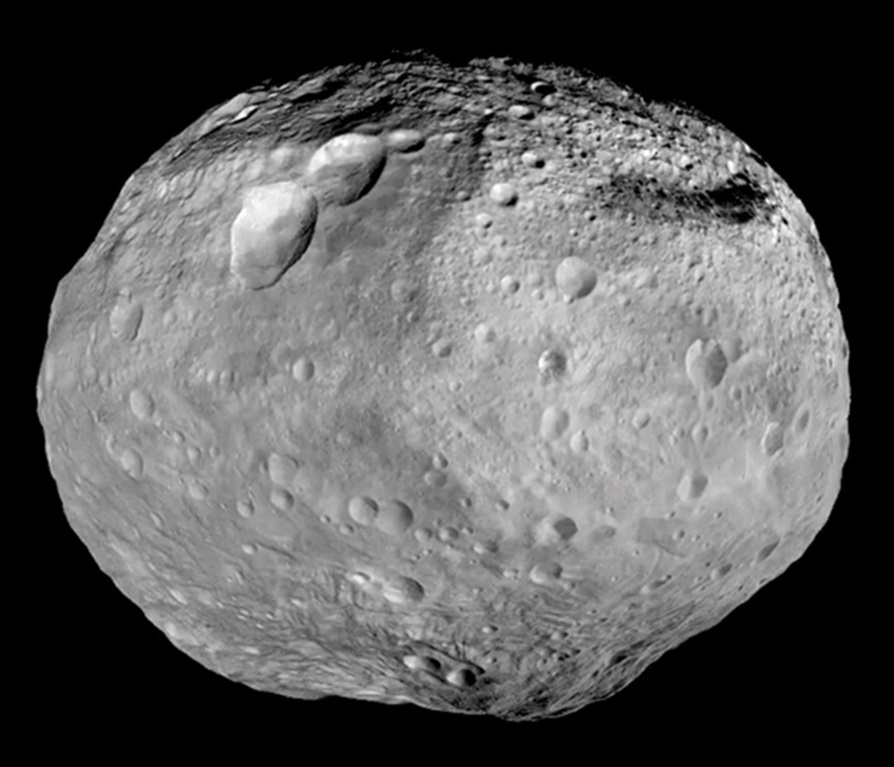
The rocky surface of asteroid is also covered by space dust.
Like planets, they revolve around the sun although erratically. Approximately 150 asteroids have companion moons, sometimes two and even three. Some asteroids even orbit each other and are referred to as binary or double asteroids or triple asteroids. These asteroids are also approximately the same size. Other asteroids succumb to the gravity of other planets and become moons in themselves. Examples of these include Phobos and Deimos, Mars’ moons, and several of the outer moons of Jupiter, Saturn, Uranus, and Neptune.
Asteroids are celestial bodies that have mostly remained the same throughout the Solar System lifetime. This has made astronomy research easier, especially when studying the early solar system. They have an average temperature of minus 73 degrees Celsius. The surface facing the Sun can be as hot as -20°C and the other side -190°C.
Though they have remained relatively the same throughout time, they have quite varying shapes and structures. Some are one solid piece, while others are an agglomeration of rubble. There are some with up to six tails and others came with rings, like Saturn and the other large planets.
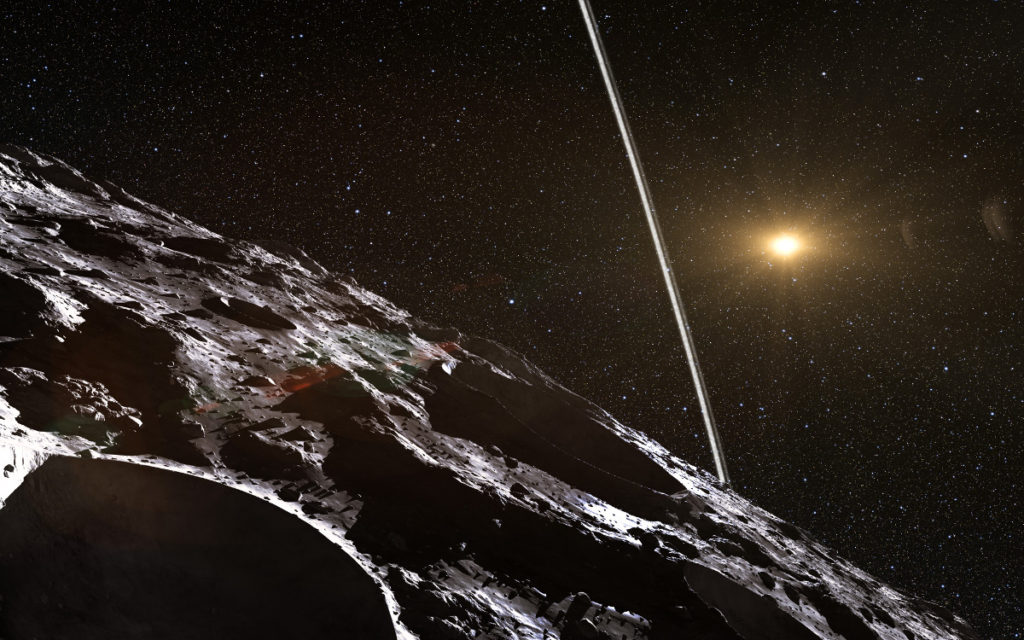
Classification
Asteroids are classified as: Main Asteroid Belt, Trojans, and Near Earth Asteroids.
Main Asteroid Belt — The region between Mars and Jupiter is known as the asteroid belt. The majority of asteroids are found within this area. It is speculated that about 1.1 million to 1.9 million asteroids with a diameter of 1 kilometer can be found in this area and most don’t have elongated orbits. When Jupiter formed, its gravity caused the end of the formation of celestial bodies to form in that region. The small bodies collided and resulted in the formation of the belt.
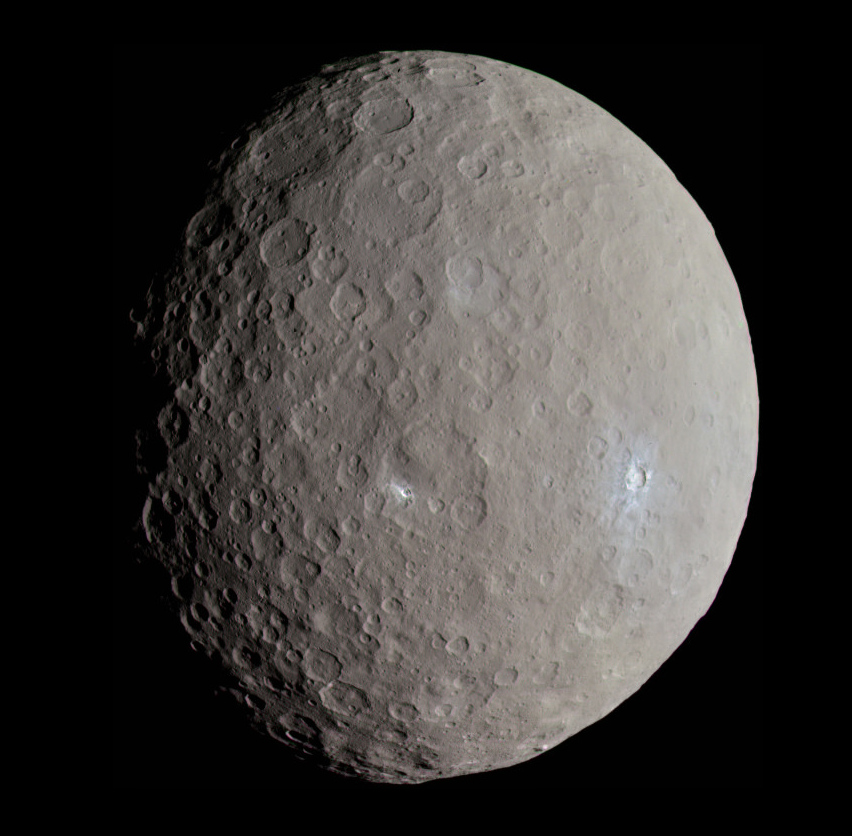
However, not all bodies within this region are asteroids. In fact, Ceres was reclassified as a dwarf planet. Some asteroids within the belt have tails and are thought to be comets disguised as asteroids. The belt is between 2 to 4 AU from the Sun and is further subdivided into Hungarias, Floras, Phocaea, Koronis, Eos, Themis, Cybeles, and Hildas.
The asteroid with a tail is named Phaethon. It has a high eccentric (i.e. not circle). At its closest to the Sun, it is at about half the position of Mercury. It is furthest away position, it is in the Asteroid belt. We are not sure what causes the tail because Phaethon is not composed of ice like comets. The closest it came to Earth was 10 million kilometers. However, its orbit doesn’t cross Earth orbit, so we are not in danger of encountering Phaethon for a very long time.
Trojans — These asteroids orbit larger planets at Lagrange points (L4 and L5). Lagrange points are where the gravitational pull of the Sun and the planet are balanced.
The majority of Trojans orbit the planet Jupiter. Mars and Neptune also have Trojans, although Jupiter Trojans are in the majority. It is said that there are as many asteroids there as there are asteroids in the asteroid belt.
In 2011, NASA discovered a Trojan orbiting our planet. There are more asteroids in L4 than in L5. A few smaller asteroids can be found in the Lagrange points of Venus and Earth. 5261 Eureka is an example of a Mars Trojan and that asteroid is like mini-planetary system since a tiny asteroid (0.42km in diameter) orbits 5261 Eureka.
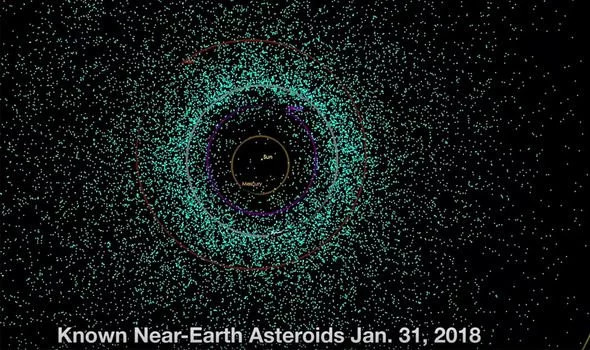
Near-Earth Asteroids — Near-Earth asteroids come close to Earth. The closest and most recent being the ones mentioned at the top of this article. There are four types of Near-Earth Asteroids:
- Amor asteroids come close to the Earth but do not cross our orbit, like Phaethon.
- Aten asteroids cross Earth’s orbit twice per period and stay close to the Earth orbit.
- Apollo asteroids have orbits that cross the Earth’s but spend much more time outside its orbit.
- Atira asteroids have their orbits within Earth’s orbit (they are closer to the Sun than the Earth).
About 10,000 of all the asteroids on record are Near-Earth Asteroids.
General Asteroid Types
There three main compositions of asteroids: C-Type, S-Type and M-Type.
C-Type — This is the most common type of asteroid – about 75% of all asteroids are of this type. They are grey in color and are thought to be made of clay and silicate rocks. They are some of the oldest celestial bodies on record.
S-Type — These asteroids are green or red in color. About 17% of all asteroids are S-Type and they can mainly be found in the inner asteroid belt. Their appearance makes astronomers infer that they are made up of silicate material and/or nickel-iron.
M-Type — The rest of the asteroids are of this type. They are made of nickel-iron and are red in color. They occupy the middle belt. These asteroids formed close to the sun and experienced high temperatures after their formation. This led to melting and iron sunk to the center and volcanic lava formed on the surface. Possibly a similar process happened on Earth.
Unpredictable Movements
Jupiter’s extreme gravity and its alignments with Mars have changed the orbit of asteroids within this region. This has led to collisions with other planets and with other celestial bodies. Previously, these asteroids also came into contact with Earth and this changed the geological shape of the planet and played a big part in the evolution of life on the blue planet.
According to NASA, the danger of large and dangerous asteroids hitting our planet is minimal. NASA speculates that for an asteroid to cause enough damage on Earth, its diameter would have to be more than a quarter of a mile. Asteroids this large strike the planet once every 1,000 centuries. If this event were to take place, it would cause a nuclear winter due to the dust that would end up in the atmosphere.
Smaller asteroids strike the planet every 1,000 to 10,000 years. These objects could destroy whole towns or cities and cause tsunamis when falling in a sea or an ocean. In 2013, such an asteroid hit Chelyabinsk in Russia. The impact caused shock waves that led to over 1,000 people suffering injuries. The asteroid was a mere 20 meters wide by the time it entered the Earth’s atmosphere.
The discovery of Near Earth Asteroid is generally made with a standard telescope, i.e. a telescope looking at visible light. Once we detect an asteroid, we calculate its trajectory. Then to monitor these Near-Earth objects, astronomers use radar when they come within a few million kilometers.
Meteorites
| Element | Percent |
|---|---|
| Metallic Meteorite | |
| Iron | 91% |
| Nickel | 8.5% |
| Cobalt | 0.6% |
| Stony Meteorite | |
| Oxygen | 6% |
| Iron | 26% |
| Silicon | 18% |
| Magnesium | 14% |
| Aluminium | 1.5% |
| Nickel | 1.4% |
| Calcium | 1.3% |
Once an asteroid hits our planet, it is known as a meteorite.
There are two spacecrafts currently observing asteroids: NASA’s OSIRIS-REX and Japan’s Hayabusa-2. NEOWISE is used to observe Near-Earth objects. CNEOS software is also used to identify these objects. Recently, NASA announced that an asteroid was heading towards Earth and was expected to pass on the Eve of the US presidential elections. The probability of this asteroid hitting Earth is only 0.41%, meaning it is of no significant threat to us.
It’s believed that asteroid collisions are what led to life on the planet. Asteroid and comet collisions led to water-ice and carbon molecules being deposited on our planet and that made it possible for life to evolve into what we know today.
Unfortunately, it’s also known for its destructive power. When the Dinosaurs died out, we can see an event in the Earth curst: a thin deposity of black material, a remains of a giant asteroid that fell in what is now the Yucatan Golf of Mexico.
The Palomar Observatory was the first to observe asteroid 2018VP and to find out that it’s not a hazardous object as calculated by NASA. The asteroid that passed earlier in the month of August 2020, as mentioned above, would have gone through the Earth’s atmosphere without much resistance, was it to hit. The asteroid was named 2020 QG.
Other Interesting Facts
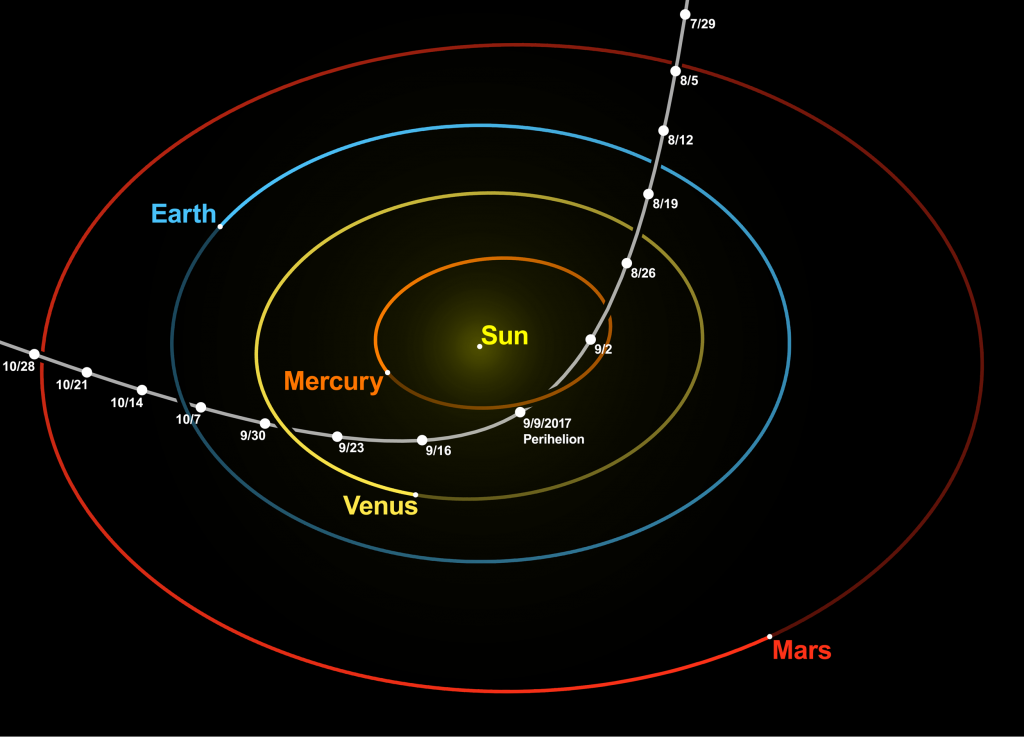
- Previously we’ve had an article on ʻOumuamua, the interstellar interloper. Though previously thought to be a comet, ʻOumuamua was reclassified as an asteroid. It is the first known object from another star to visit our solar system and there are several theories on what it really is: an alien spyware, a comet, a lost natural asteroid. NASA however first termed ʻOumuamua as a comet because of its trajectory around the Sun, but due to lack of a coma which is characteristic of all comets, it was recategorized as an asteroid. We know of a few asteroids that have an orbit that goes outside of our solar system. 2060 Chiron (aka 95 P/Chiron) orbits between Saturn and Uranus. The orbit of 5335 Damocles ranges from near Mars to beyond Uranus. 5145 Pholus orbits from Saturn to past Neptune.
- On average 17 asteroids large enough to reach the ground fall on our planet every day. Most asteroid, though, are small and they usually burn up way before landing on the ground.
- Asteroids are considered to be the cause of the extinction of dinosaurs 65 million years ago.
- Some asteroid showers seen on Earth are actually due to comets passing the Earth orbit. When comets approach the Sun, they generate a tail of material which will float in space until the Earth crosses the same area.
- Several spacecrafts have landed on asteroids over the years. According to NASA, at least 10 spacecrafts have landed on these celestial bodies including; NEAR Shoemaker which landed on 433 Eros in 2001, surviving there for several weeks. Dawn Spacecraft orbited asteroid Vesta for months between 2011 and 2012 and in 2010, Hayabusa came back with samples of the asteroid Itokawa had taken in the year 2005.
- Charilko, an asteroid discovered in 2013 was found to have rings. This discovery was made by scientists when they discovered that when it passed in front of a star, it made the background blink. It has two rings to be specific.
- The asteroid 4Vesta is said to have differential layers similar to a terrestrial planet. This could mean that there is internal heat in the center, in addition to the heat released from isotopes. The heat from isotopes alone would not be enough to result in melting.
- Asteroids are known as minor planets since they have similar characteristics to other planets. Some have water flowing from their surface such as the asteroid Vesta. In 2015, gullies were observed that were assumed to be from water flowing on the surface. It has been assumed that when smaller asteroids slam into bigger asteroids, they release their ice onto the bigger asteroid. This ice turns into water that flows on the surface.
- Though they have similarities to planets, they are too small to support life. Their size is too small to hold atmosphere and their gravity is too weak to form a complete sphere. According to NASA, the mass of all asteroids in the solar system is smaller than the mass of our Moon.
- There is little knowledge of the density of asteroids. But using the Doppler Effect on radio waves returning from to the Earth from a Near-Earth Asteroids, we were able to measure the density of asteroid Mathilde. Its density was surprisingly not much more than that of water. This led them to conclude that perhaps it wasn’t a completely solid but a large pile of debris.
- We estimate that there are about 4.6 billion asteroid in our solar system. We can find them all around from very close to the Sun to some asteroid orbiting outside of the solar system. So far, we’ve mapped only about 800,000 of them.
How Asteroids Get Their Names
The naming process for asteroids is less strict in comparison to the naming processes of other bodies. The International Astronomical Union’s Committee on Small Body Nomenclature is responsible for naming asteroids. Names vary from numbers and symbols to cooler names such as Mr. Spock (Star Trek reference), Frank Zappa (American singer), and even after school teachers. Some have been named after deceased astronauts. There isn’t a particularly strict rule on how they are named.
Since we detected well over 800,000 asteroids by now, we really only gave names to the most prominent ones. Most of the others are given scientific names, letters and numbers that determine their type, basic location/orbit, and other basic characteristics.
Like other celestial bodies, there is still so much to be learned about asteroids. For example: Why are there more Trojans in the L4 Lagrange point than in the L5 Lagrange point? What is the likelihood that a large asteroid will cause significant damage to Earth? What is their complete composition? Though at times visible with our naked eyes, astronomers use binoculars, telescopes, and radars to learn more about them.

Leave a Reply